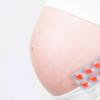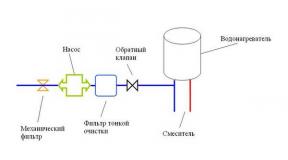Little thrombocytopenia is dangerous. Why in the blood decreases platelet levels - the causes of thrombocytopenia. Other signs of external bleeding include
- Quantitative disruption of thrombocyte hemostasal link, characterized by a decrease in platelets in a unit of blood volume. Clinical signs Thrombocytopenia includes increased bleeding from damaged skin and mucous membranes, a tendency to form bruises and hemorrhagic rash, spontaneous bleeding of various localities (nasal, gantry, gastric, uterine, etc.). Hematological diagnostics is based on studying general analysis blood counting of platelets, immunological examination, research bone marrow. Possible methods of thrombocytopenia treatment are drug therapy, splenectomy, elecorporal blood purification.
General
Thrombocytopenia - various in etiology, pathogenesis and flow hemorrhagic diathesis, characterized by a tendency to increased bleeding due to a decrease in the number of blood plates. The threshold criterion of thrombocytopenia in hematology is considered to be the level of platelets below 150x109 / l. However, the unfolded clinical pattern of thrombocytopenia is usually developing with a decrease in platelets to 50x109 / l, and the level of 30x109 / l and below is critical. Physiological thrombocytopenia arising from women during menstruation or pregnancy (gestational thrombocytopenia) usually does not reach a pronounced degree. Pathological thrombocytopenia, due to various reasons, occur in 50-100 people from 1 million.
Platelets (Bizzoco plaques) are small blood plates in size of 1-4 microns. They are formed from bone marrow megacariocytes with the direct stimulating effect of thrombopoietin polypeptide hormone. Normal level platelet is 150-400x109 / l; Approximately 70% of platelets continuously circulates in peripheral blood, and 1/3 of part is in the spleen depot. The average lifespan of platelets is 7-10 days, after which their destruction occurs in the spleen.
Classification
Thrombocytopenia is customary to be classified on the basis of a number of features: the causes, nature of the syndrome, the pathogenetic factor, the severity of hemorrhagic manifestations. According to the etiological criterion, primary (idiopathic) and secondary (acquired) thrombocytopenia are distinguished. In the first case, the syndrome is an independent disease; In the second - develops secondary, under a number of other pathological processes.
Thrombocytopenia may have an acute course (duration of up to 6 months, with a sudden beginning and fast decline The number of platelets) and chronic (duration of more than 6 months, with a gradual increase in manifestations and a decrease in platelet levels).
Taking into account the presenter pathogenetic factor allocate:
- thrombocytopenia dilution
- thrombocytopenia distribution
- thrombocytopenia consumption
- thrombocytopenia due to the insufficient formation formation
- thrombocytopenia, due to increased fracture of platelets: non-immune and immune (alloimmune, autoimmune, transmmune, heteroimmune)
The criterion for the severity of thrombocytopenia is the level of blood platelets and the degree of hemostasis violation:
- I. - Number of platelets 150-50x109 / l - hemostasis satisfactory
- II. - the amount of platelets 50-20 x109 / l - with insignificant injury there are intradermal hemorrhages, petechia, long bleeding from wounds
- III - The number of platelets 20x109 / l and below - the spontaneous internal bleeding develops.
Causes of thrombocytopenia
Congenital thrombocytopenia are mostly part of hereditary syndromes, such as the syndrome of Viscota-Aldrich, Fanconi anemia, Bernard Sulieus syndrome, anomalia of Maya-Hegglin, etc. Since qualitative changes of platelets are also observed in hereditary thrombocytopenia, they are considered to be thrombocytopathy.
The causes of acquired thrombocytopenia are extremely diverse. Thus, the reimbursement of blood loss with infusion media, plasma, the erythrocyte mass can lead to a decrease in platelets concentrations by 20-25% and the occurrence of the so-called, thrombocytopenia of breeding. The thrombocytopenia of the distribution is the sequestration of platelets in the spleen or vascular tumors - hemangiomas with the shutdown of a significant amount of platelet mass from the total blood flow. Thrombocytopenia distribution can develop with diseases accompanied by massive splenomegaly: lymphomas, sarcoidosis, portal hypertension, spleen tuberculosis, alcoholism, Goshe disease, Felty syndrome, etc.
The most numerous group consists of thrombocytopenia due to increased tombstroaction destruction. They can develop both due to the mechanical destruction of platelets (for example, during the prosthetics of cardiac valves, artificial blood circulation, paroxysmal night hemoglobinuria) and in the presence of the immune component.
Alloimmune thrombocytopenia may be a consequence of transfusion of foreign blood; Transimmune - penetration of maternal antibodies to platelets through a placenta to the fetus. An autoimmune thrombocytopenia is associated with the production of antibodies to their own unchanged platelet antigens, which is found in idiopathic thrombocytopenic purpura, a systemic red lcanque, autoimmune thyroid, myeloma, chronic hepatitis, HIV infection, etc.
Heteroimmune thrombocytopenia is due to the formation of antibodies against alien antigens that are fixed on the surface of platelets (medicinal, viral et al.). Drug-induced pathology occurs when taking sedative, antibacterial, sulfanimide drugs, alkaloids, gold, bismuth compounds, heparin injections, etc. Reversible temperate reduction in the number of platelets is observed after transferred viral infections (adenoviral infection, influenza, chickenpox, rubella, measles, infectious mononucleosis), vaccination.
Thrombocytopenia, due to the insufficient formation of platelets (productive), are developing with a deficiency of stem hematopoietic cells. This condition is characteristic of aplastic anemia, acute leukemia, myelofibrosis and myelosclerosis, tumor metastases in the bone marrow, iron deficiency, folic acid and vitamin B12, effects of radiation therapy and cytostatic chemotherapy.
Finally, the thrombocytopenia of consumption arises due to the increased need of platelets to ensure blood coagulation, for example, in DVS syndrome, thrombosis, etc.
Symptoms of thrombocytopenia
Typically, the first signal reduction in platelet levels is the appearance of skin hemorrhages with insignificant injury (impact, squeezing) of soft tissues. Patients note the frequent occurrence of bruises, a specific fine-point rash (petechy) on the body and limbs, hemorrhages in the mucous membranes, the increased bleeding of the gums, etc. during this period, the thrombocytopenia is detected only on the basis of the changes of the hemogram, often studied on another occasion.
At the next stage, there is an increase in the time of bleeding with minor cuts, long-term and abundant menstrual bleeding in women (menorgia), the appearance of ekkimosis in the fields of injection. Bleeding caused by injury or medical manipulation (for example, tooth extraction) can continue from several hours to several days. Splenomegalia during thrombocytopenia is usually developing only against the background of concomitant pathology (autoimmune hemolytic anemia, chronic hepatitis, lympholecosis, etc.); The increase in the liver is not characteristic. In the case of the attachment of arthralgia, it is necessary to think about the presence of a patient for collagenis and the secondary character of thrombocytopenia; With a tendency to the formation of deep visceral hematomas or hemarthrosis - about hemoblastosis and requires a more in-depth examination (conducting sternal puncture, trepalobiopsy).
To exclude Coagulopathy, a hemostasiogram is investigated; With suspected autoimmune character, thrombocytopenia is determined by antitrombocyte antibodies. The possible cause of thrombocytopenia makes it possible to identify the ultrasound of the spleen, the radiography of the chest, an immunofermental blood test. Differential diagnosis It is carried out between different forms of thrombocytopenia, as well as with Willebrand's disease, hemophilia, pernicious anemia, thrombocytopathy, etc.
Treatment of thrombocytopenia
When establishing the secondary nature of thrombocytopenia, the main treatment is the therapy of the underlying disease. At the same time, the presence of pronounced hemorrhagic syndrome requires the hospitalization of the patient and the provision of emergency medical care. With active bleeding, platelet transfusions are shown, the purpose of angioprotectors (ethacilase), fibrinolysis inhibitors (aminocaproic acid). The reception of acetylsalicylic acid, anticoagulants, NSAIDs is excluded.
Patients with idiopathic thrombocytopenic purple is carried out glucocorticoid therapy, intravenous administration Immunoglobulin, chemotherapy with cytostatics. In some cases (with non-efficiency of drug therapy, repeated bleeding), splenectomy is shown. In the thrombocytopenia of a non-immune character, symptomatic hemostatic therapy is carried out.
Thrombocytopenia can cause many common drugs (Table 117.1).
In addition to cytostatics, the inhibition of blood formation and transient thrombocytopenia cause large doses of alcohol. It especially often arises during the binge.
Tiazide diuretics can also disrupt the formation of megakaryocytes and cause light thrombocytopenia (50,000-100000 1 / μl), which remains several months after the cancellation of the drug.
Most often, the medicinal thrombocytopenia is based on the immune response, a random victim of which platelets become. They are damaged when the complement is activated after the formation of the antibody complex. The bone marrow can also show up an isolated increase in the number of megacariocytes.
Existing laboratory methods allow you to establish a combination of thrombocytopenia with medication reception only in 10% of patients. Therefore, the best confirmation of the diagnosis is fast growth platelet levels after canceling a suspected drug.
Most patients are recovered for 7-10 days without any treatment, however, some of them have a decrease in platelets below 10,000-20,000 1 / μl, severe bleeding arise, requiring the temporary purpose of glucocorticoids, plasmapheresis or transfusion of platelets. After recovery, the patient should continue to avoid the reception of this drug, since it is sufficiently minor than its number of immune response.
Drugs such as phenytoin or gold preparations slowly leave the tissue depot and can cause long-lasting thrombocytopenia.
In stationary patients, heparin is a frequent cause of thrombocytopenia. Approximately 10-15% of patients receiving heparin in therapeutic doses develop thrombocytopenia, which may be accompanied by severe bleeding or intravascular aggregation of platelets with thrombosis. This complication, which sometimes called "White Thrombov Syndrome" is very dangerous and should be recognized on time. Although the direct agglutination of platelets of heparin, heparinic thrombocytopenia is usually associated with sedimentation on the platelets of immune complexes. An antigen is used with a heparin complex with a platelet factor 4. Immediate cancellation of heparin leads to the reverse development of both thrombocytopenia and hydrocarbon-induced thrombosis.
The incidence of heparinic thrombocytopenia may decrease due to the transition to low molecular weight heparins, as these preparations prevent thrombosis and less immunogenic. Unfortunately, with already existing antibodies, this is not an output, since antibodies to the conventional heparin in 80% of cases react crosswise with low molecular weight.
Thank you
The site provides reference information solely to familiarize yourself. Diagnosis and treatment of diseases must be under the supervision of a specialist. All drugs have contraindications. Consultation of a specialist is obligatory!
What is thrombocytopenia?
Thrombocytopenia - pathological condition characterized by a decrease in the number thrombocyte (red blood plates) in the bloodstream to 140,000 / μl and below (normally 150,000 - 400,000 / μl).Morphologically platelets are devoid of small fragments of megakaryocyte cytoplasm. These are the smallest blood elements that occur from the megacariocyte - the largest cell predecessor.
Red blood plates are formed by separating the portions of the maternal cell in the red bone marrow. This process is not sufficiently studied, but it is known that it is manageable - with increased demands in platelets, the speed of their formation sharply increases.
The lifespan of platelets is relatively small: 8-12 days. Old degenerative forms are absorbed by fabric macrophages (about half of red blood plates ends their life cycle in the spleen), and new ones come from the red bone marrow.
Despite the absence of the nucleus, platelets have many interesting features. For example, they are capable of active directed amoeboboid movement and phagocytosis (absorption of alien elements). Thus, platelets are involved in local inflammatory reactions.
The outer platelet membrane contains special molecules that can recognize damaged vessels. Finding small damage in the capillary, the blood plate sticks to the affected area, embedded in the vessel dill in the form of a live patchwork. Therefore, with a decrease in the number of platelets in the bloodstream, multiple small point hemorrhages appear, called diapered.
However, the most important feature of platelets is that they play a leading role in stopping bleeding:
- form a primary platelet cork;
- identify factors contributing to the vessel narrowing;
- participate in the activation of a complex system of coagulation factors of blood, which ultimately leads to the formation of a fibrin bunch.
Causes and pathogenesis of thrombocytopenia
In accordance with physiological features the life cycle of blood plates, you can highlight the following reasons The occurrence of thrombocytopenia:1. Reduced formation of blood plates in the red bone marrow (thrombocytopenia of products).
2. Increased destruction of platelets (thrombocytopenia of destruction).
3. Redistribution of platelets, causing a decrease in their concentration in the bloodstream (thrombocytopenia of redistribution).
Reducing platelet formation in red bone marrow
 Thrombocytopenia associated with the reduced formation of platelets in the Red bone marrow, in turn, can be divided into the following groups:
Thrombocytopenia associated with the reduced formation of platelets in the Red bone marrow, in turn, can be divided into the following groups:
- thrombocytopenia associated with the hypoplasia of the megacariocytic sprout in the bone marrow (insufficient formation of platelet progenitor cells);
- thrombocytopenia associated with ineffective thrombocytopoese (in such cases is formed normal, or even increased quantity predecessor cells, however, for one reason or another, the formation of platelets from megakaryocytes is violated);
- thrombocytopenia associated with metaplasia (substitution) of the megacariocyte sprout in the Red Bone Mody.
Gypoplasia of the megacariocytic sprout of a red bone marrow (insufficient products of platelet progenitor cells)
On the hypoplasia of the megacariocyte sprout, they are talking in cases where the bone marrow is not able to provide a daily substitution of 10-13% of platelets (the need for such a quick replacement is associated with a small life expectancy of blood plates).
The most common cause of the hypoplasia of the megacariocyte sprout is aplastic anemia. In this disease, the total hypoplasia of all hematopoietic cells (precursors of erythrocytes, leukocytes and platelets) occurs.
The bone marrow hypoplasia with the development of thrombocytopenia can cause many drugs, such as: Levomycetin, cytostatics, anti-random agents, gold preparations.
The mechanisms of the action of drugs may be different. Cyticostatics have a direct depressing effect on the bone marrow, and levomecitin can lead to thrombocytopenia only in the case of idiosyncraysia (individual increased sensitivity of the bone marrow to this antibiotic).
There are experimental data proving the oppression of a megacariocytic sprout under the action of alcohol. In such cases, thrombocytopenia does not reach extremely low numbers (up to 100,000 / μl), is not accompanied by pronounced bleeding and disappears 2-3 days after a complete abandonment of alcohol intake.
The direct cytopathic effect on the megacariocytes also has a human immunodeficiency virus. Often, HIV-infected is developing expressed thrombocytopenia products.
Sometimes generalized bacterial or fungal infections (sepsis) become the cause of the oppression of the megacariocytic sprout (sepsis). Most often, this kind of complications are developing in childhood.
In such cases, as a rule, all sprouts of the hematopoietic fabric suffer, which is manifested by pancytopenia (decrease in the number of cell elements in the blood - erythrocytes, leukocytes and platelets).
Increased consumption (destruction) platelets
Accelerated thrombocyte destruction is the most common cause of thrombocytopenia. As a rule, the increased consumption of blood plates leads to a bone marrow hyperplasia, an increase in the number of megacariocytes and, accordingly, to increase the formation of platelets. However, when the destruction speed exceeds the compensatory abilities of the red bone marrow, thrombocytopenia develops.The thrombocytopenia of destruction can be divided into due immunological and non-immunological mechanisms.
Destruction of platelets by antibodies and immune complexes (immune thrombocytopenia)
Thrombocytopenia in persons with normal production of blood cells in the predominant majority of cases is due to the destruction of platelets under the influence of various immune mechanisms. At the same time, antithromobocutary antibodies are formed, which can be found with a special immunological examination.
For all immune thrombocytopenia, the following signs are characterized without exception:
- lack of pronounced anemia and leukopenia;
- the sizes of the spleen within the norm, or increased slightly;
- an increase in the number of megacariocytes in the red bone marrow;
- reducing the life expectancy of platelets.
1. Iso immune - caused by alloantite products (antibodies to the antigens of platelets of another organism).
2. Autoimmune - caused by the production of autoantiboders (antibodies to the antigens of platelets of their own organism).
3. Immune - provoked by the reception of drugs.
Immune thrombocytopenia that occurs when the "Aliens" platelets
Isoimmune thrombocytopenia occurs when "other people's" platelets (blood transfusion, pregnancy) occur in the body of "foreign" platelets. This group of pathologies includes neonatal (infant) alloimmune thrombocytopenic purpura, post-transfusion purple and refractoriness (stability) of patients to blood transfusion.
Neonatal Alloimmune Thrombocytopenic Purple (NTP) It occurs during the antigenic incompatibility of the mother and the child in platelet antigens, so that the blood of the fetus is made by maternal antibodies that destroy the fetal platelets. This is quite rare pathology (1: 200 - 1: 1000 cases), the severity of which depends on the power of the immune response of the mother.
Unlike the incompatibility of the mother and the fetus by the Rh Factor, NPP can develop during the first pregnancy. Sometimes thrombocytopenia in the fetus occurs already at the 20th week of intrauterine development.
Pathology is manifested by generalized phetechial rash (point hemorrhages) on the skin and mucous membranes, melanoma (aqueous feces, indicating internal bleeding), nasal bleeding. 20% of children develop jaundice. Internal hazers represent intracerebral hemorrhages that develop each third child with NATP.
Post transfusion thrombocytopenic purple It develops 7-10 days after blood transfusion or platelet mass, and is manifested by pronounced bleeding, hemorrhagic skin rash and a catastrophic drop in the number of platelets (up to 20,000 / μl and below). The mechanism of development of this is extremely rare complication has not yet been studied.
Refractory (insensitivity) patients with platelet transfusions It develops extremely rarely with repeated transfusions of blood products containing platelets. At the same time, the level of platelets in patients remain unchanged low, despite the flow of donor blood plates.
Autoimmune thrombocytopenia
An autoimmune thrombocytopenia is associated with premature thrombocyte deaths as a result of the action of antibodies and immune complexes generated to platelets of their own organism. At the same time, primary (idiopathic, unknown etiology) and secondary (caused by known causes) autoimmune thrombocytopenia are distinguished.
The primary includes acute and chronic idiopathic autoimmune thrombocytopenic purpura. To the secondary - many diseases in which autoantibodes arise to blood plates:
- malignant lemphoid tissue tumors (chronic lympholoicosis, lymphoma, lymphogranulomatosis);
- acquired autoimmune hemolytic anemia (Evans Fisher syndrome);
- systemic autoimmune diseases connective tissue (system red lupus, rheumatoid arthritis);
- organship-specific autoimmune diseases (autoimmune hepatitis, nonspecific ulcerative colitis, Crohn's disease, autoimmune thyroiditis, ankylosing spondyloarthritis);
- viral infections (rubella, HIV, slimming herpes).
- Aspirin;
- Rifampicin;
- Heroin;
- Morphine;
- Cimetidine;
Non-immune causes of platelet destruction
First of all, the increased destruction of platelets can occur in pathologies associated with a violation of the state of the inner cut of the vessels, such as:
- postoperative changes (artificial valves, synthetic vessel shunts, etc.);
- pronounced atherosclerosis;
- defeat vessels with metastases.
Reducing the number of platelets can also be observed with strong blood loss and massive transfuses (with intravenous injection of a large amount of solutions - the so-called thrombocytopenia of dilution).
Violation of the distribution of thrombocyte
 Normally from 30 to 45% of the active blood flows are located in the spleen, which is a kind of depot of blood plates. With raising the need for platelets, blood plates emerge from the depot to blood.
Normally from 30 to 45% of the active blood flows are located in the spleen, which is a kind of depot of blood plates. With raising the need for platelets, blood plates emerge from the depot to blood. In case of diseases, accompanied by a significant increase in spleen, the number of platelets in the depot increase significantly, and in some cases it can reach 80-90%.
With a long delay in platelets in the depot, their premature destruction occurs. So with the time of thrombocytopenia distribution proceeds in the thrombocytopenia of destruction.
Most often, this kind of thrombocytopenia occurs under the following diseases:
- liver cirrhosis with the development of portal hypertension;
- oncological diseases of the blood system (leukemia, lymphoma);
- infectious diseases (infectious endocarditis, malaria, tuberculosis, etc.).
Classification
The classification of thrombocytopenia under the mechanism of development is inconvenient for the reason that many diseases are involved in many diseases of thrombocytopenia.Its activity in 80-90-year-olds is significantly lower than 20-30-year-olds. Such age decline in part may be explained by the reception of medicines.
The hemolytic anemia of this type should be thought if the history has information about the recently completed or continued course of drug therapy, and the Cumbas test is negative. Anemia usually occurs sharply and may be accompanied by signs of intravascular hemolysis. Less often in the patient found signs chronic anemia. In the stage of remission in the peripheral blood of any biochemical anomalies, it is not possible to detect; However, when hemolysis is increased due to the action of a drug or severe acute infection, diabetic keto-acidosis or renal failure In the study of erythrocytes, anisocytosis, polychromatophyla, basophilic puncture, spherositosis and the Taurus of the Heinz are revealed.
To the number of drugs that are prescribed by the elderly patients and which can cause them anemia of this type, belongs sulfonamides, acetylsalicylic acid, furaconin, PASK, Samplesid, Kinin, Primahin and diphenyl sulfone.
Forecast
The forecast for hemolytic anemia is generally favorable. However, after stopping the drug, recovery can delay for several weeks.
Treatment
There is no specific treatment; It is only necessary to stop taking a medication that caused anemia .. Useful steroids may be useful. Patients should be prevented about the need to refrain from taking this drug in the future.
Thrombocytopenia
This is the most common form of medicinal cytops, however, mortality with it is the smallest. 20 years ago
ger, Wester-Holm, 1972a; Bottiger et al., 1979b]; Women are amazed more often.
The most common cause of thrombocytopenia is oral diuretics (including tiazide derivatives, oxodolia and furosemide) and Cinene (County), Bottiger et al. (1979b) showed that from 1966 to 1975
the number of cases of thrombocytopenia caused by butadion decreased, and the number of cases caused by sulfonylamide, increased. These data contradict the results ofTimoney (1978) r which on the basis of the messages received to the Irish National Advisory Bureau drugsIt has shown that about half of all cases of thrombocytopenia were associated with the reception of indomethacin, butadion and oxyphenbutazone. This group of drugs is in the first place. "" According to the data directed to the WHO Center.
Clinical manifestations
Thrombocytopenia may have a selective character of il "to be one of the components of aplastic anemia. In the first case, it manifests itself in the form of gradually increasing or
suddenly emerging weak or heavy bleeding, which initially indicates the appearance of petechs without an inflammatory response. At first they arise around the mouth, and then on the limbs and torso. Later, ekkimosis appear, nasal bleeding, hemorrhage into mucous membranes, germino-intestinal bleeding, hematuria and intracerebral hemorrhages. In patients with immune thrombocytopenia, fever, vomiting and abdominal pain are also observed. During the examination, only signs of bleeding and a positive test of hess are usually detected. However, this sample in the elderly needs to be interpreted with caution.
Laboratory research
According to laboratory studies, in light cases, the number of platelets falls below100 · 109 / l, and in heavy - below 20 · 109 / l. Neutropenia is usually absent, and leukocytosis may occur after acute blood loss. The time of bleeding is elongated, and the thickening retraction is broken. When studying the bone marrow, a normal or increased number of megacariocytes is detected. It may be necessary
conduct tests for detecting antibodies to platelets or platelet damage, for example, the discharge reaction of the platelet factor III and the complement binding response.
Pathogenesis
There are two main mechanism for the development of thrombocytopenia. The first is the destruction of platelets in peripheral blood, usually as a result of the action of immunological factors, for example, during reception of quinine (chinidine), and occasionally, as a result of a direct toxic effect; The second consists in reducing platelet products in the bone marrow (for example, as a result of treatment with heparin and paracetamol).
Drugs causing thrombocytopenia
Oral diuretics.These drugs often cause thrombocytopenia, but in reality the frequency of its occurrence compared to the high frequency of the appointment of the diuretics themselves, apparently, is small and equals, according to Bottiger, Westerholm (1972b), 1: 15000. Weak, asymptomatic changes are found in 25% of patients receiving chlorodiazide, the elderly frequency of such changes may be higher than i. Thrombocytopenia symptoms are usually developing gradually. In some cases, it appears to be caused by the direct toxic effect of medicinal substances, in others - the immunological mechanism. The frequency of the occurrence of thrombocytopenia when taking furosemide is 2: 1000. The case of thrombocytopenia in an elderly man caused by antibodies to platelets is described (.
Cinenian (County). These drugs are often caused by thrombocytopenia. Chinin is often prescribed to the elderly patients with nightly cramps, it is also a component of tonic drinks and a number of patented means. Hinine-related immune thrombocytopenia occurs suddenly, accompanied by severe disturbances of platelet functions and bleeding. These symptoms may occur at any time in a patient receiving chinin. Similar disorders causes County, who in the elderly may also be the cause
noah pulmonary bleeding (Libman, Goldsmith, 1972; Alperin et al.r 1980; Leblanc, 1980]. Restoration, as the right
wILOO, occurs within a week after the cancellation of the drug.
Anthealth. Previously reported on\u003e cases of thrombocytopenia caused by the reception of the butadion,oxy-phenbutazona and indomethacin, but now the number of such cases
tea-decreases, apparently, due to the fact that the estimated funds are appointed less often. Gold preparations, especially in large doses, are the cause of thrombocytopenia in patients of any age [Kau, 1970]. It can develop at an early or late phase of treatment, but sometimes purpura occurs after 2-10 months after the last injection of the drug. If the ball is not prescribed to accelerated gold, the recovery occurs slowly. The mechanism for the development of thrombocytopenia in these cases is unclear; Sometimes patients who received low doses of the drug of gold, the nature of the lesion can be immunological. You can think about the cumulative toxic effect in the case of the development of thrombocytopenia in patients who introduced high doses of the drug.
paracetamol.
Antibacterial drugs. Frequent cause of thromb-
cyt hobs are sulfonamides. This applies to combined drug - Biseptol. Salter (1973) reported that when using this drug, the second frequency of hem
tologic |
complication |
agranulocytosis |
is an |
|||
thrombocytopenia and that the latter arises mainly |
||||||
persons over 60 years old. Later in Pest. |
dickson review |
|||||
o. Information |
thrombocytopenia cases |
|||||
for which the bimodal distribution of hours was characterized. |
||||||
dependencies |
from age with the second peak between 60 and |
|||||
69 years. Occasionally, levomycetin, ampicillin, gentamicin and rifampicin are caused by thrombocytopenia
Other drugs.It is well known that heparin can cause thrombocytopenia. There are two mechanisms for its development. First, a slower reaction associated with high resistance to heparin disseminated by intravascular blood coagulation and recurrent or arising DE NOVO thrombosis is possible. This reaction occurs after intravenous or subcutaneous administration Heparin - in the form of intermittent injections or long-term infusion in a minimum or complete dose. It develops with the introduction of drugs as bullish and pork heparin. It can be based on an immunological mechanism, since Chong et al. (1982) discovered antibodies to the heparin class IgG. The second type of thrombocytopenia is characterized by weak manifestations, early start and often asymptomatic flow. It is often developing in elderly.
al., 1981], chlorpropamide, imizine, amitriptyline, doxypine, carbamazepama and cimetidine.
Forecast
Usually, the bleeding is stopped shortly after the abolition of the drug, although the normalization of platelets may require 1-2 weeks. Mortality varies greatly, in some works it is shown that it can reach 10-20%, but this is apparently due to the peculiarities of the selection of analyzed cases. Valid mortality rate,
similarly, much lower.
Treatment
Treatment is to cancel the suspect. Accelerate the offensive of remission in severe cases can
The disease that causes a decrease in the number of blood platelets is referred to as thrombocytopenia. It is about him actually will tell the article. Platelets are small blood calves that do not have colors and are meaningful components involved in blood collapse. The disease is sufficiently serious, since diseases can lead to hemorrhage in internal organs (especially in the brain), and this is a deadly end.
Classification
Like most medical diseases, thrombocytopenia has its own classification, which is formed on the basis of pathogenetic factors, causes, symptoms and various manifestations.
According to the criterion of etiology, two types of disease are distinguished:
- primary;
- secondary.
They are characterized by the fact that the primary type is manifested in the form of an independent ailment, and the secondary - provoked by a number of other diseases or pathological deviations.
For the duration of the course of the ailment in the human body, they share the ailment of two species: acute and chronic. Acute - characterized by a short-term impact on the body (up to six months), but manifested by instant symptoms. Chronic form is inherent continuous decrease in blood platelets (over six months). It is a chronic look that is more dangerous, since the treatment takes up to two years.
According to the criteria for the severity of the disease flowing, characterized by the quantitative composition of blood platelets, is distinguished by three degrees:
- I - the composition is equal to 150-50x10 9 / l - the criterion of gravity is satisfactory;
- II - 50-20x10 9 / l - reduced composition, which manifests itself with minor damage to the skin;
- III - 20x10 9 / l - characterized by appearances internal bleeding in organism.
The norm of blood cells in the body is from 140,000 to 440,000 / μl. But it is B. women's body These indicators are constantly changing. The changes affect such factors:
- menstruation;
- pregnancy;
- complications after pregnancy.
The platelets appear in the body from the bone marrow, which the blood body is synthesized by stimulating megakaryocytes. Synthesized blood plates circulate blood over seven days, after which the process of their stimulation is repeated.
According to International Classification Diseases Tenth convocation (ICD-10), this ailment has its own codes:
- D50-D89 - Diseases blood system And other types of failure.
- D65- D69 - Blood Cut Disrupts.
The reasons
Often the cause is the disease allergic reaction The organism on various medications in the end of what the drug thrombocytopenia is observed. With such a foolishness, the production of antibodies directed against the drug is observed. TO medicinal preparationsaffecting the appearance of blood insufficiency Taurus include sedatives, alkaloid and antibacterial agents.
The causes of insufficiency may also be problems with immunity caused by the effects of blood transfusions.
Especially often the disease is manifested in the mismatch of blood groups. Most often is observed in the human body autoimmune thrombocytopenia. In this case, immunity is incapable of recognizing its platelet and rejects them from the body. As a result of rejection, antibodies are developed to remove alien cells. The reasons for such thrombocytopenia are:
- Pathological insufficiency of kidneys and chronic hepatitis.
- Volchanka, dermatomyomy and sclerodermia.
- Leukemium diseases.
If the disease has a pronounced form of isolated disease, then it is referred to as idiopathic thrombocytopenia or verligo disease (Code of ICD-10: D69.3). Etiology of idiopathic thrombocytopenic purpura (ICD-10: D63.6) remains not clearly defined, but medical scientists are inclined to such an opinion that the reason for this is hereditary predisposition.
It is also characteristic of the disease in the presence of congenital immunodeficiency. Such people are most susceptible to the factors of the occurrence of disease, and the reasons for this are:
- damage to the red bone marrow from the effects of drugs;
- immunodeficiency leads to the danger of megacariocytes.
The productive nature of the disease occurs, which is due to the insufficient production of platelets of the bone marrow. In this case, their insufficiency arises, and as a result, flowing into indisposition. The causes of the occurrence are myelosclerosis, metastases, anemia, etc.
The lack of platelets in the body is observed in people, with a reduced composition of vitamin B12 and folic acid. Excessive radioactive or radiation effects are not excluded for the emergence of blood cells.
Thus, two types of reasons affecting the occurrence of thrombocytopenia can be distinguished:
- Leading to the destruction of blood taurus: idiopathic thrombocytopenic purpura, autoimmune deviations, surgical interventions on the heart, clinical circulatory disorder in pregnant women and side effects of drugs.
- Contributing to a decrease in the production of the bone marrow antibodies: viral influences, metastase manifestations, chemotherapy and irradiation, as well as the excess of alcohol consumption.
Symptomatics
Symptoms of thrombocytopenia disease have different kinds manifestations. It depends:
- first, the cause of the occurrence;
- secondly, on the nature of the course of illness (chronic or acute).
The main signs of defeat the organism are manifestations on the skin in the form of hemorrhages and bleeding. Hemorrhages are observed most often on the limbs and torso. The defeat of the face and lips of man is not excluded. For clarity of the manifestation of hemorrhages on the human body, a photo is presented below.

Thrombocytopenia is characterized by symptoms of prolonged hemorrhages after removal of the tooth. Moreover, the duration of hemorrhage can be both one-day and accompanied within a few days. It depends on the degree of the disease.
In symptoms, there is no increase in the size of the liver, but very often doctors watch the expansion lymph nodes cervical. Such a phenomenon is often accompanied by an increase in body temperature to subfebrile values \u200b\u200b(from 37.1 to 38 degrees). Increasing the rate of occurrence of erythrocytes in the body is evidence of the prettification of red lupus name.
Quite easily observed symptoms of platelet insufficiency after taking blood for analysis. The quantitative composition will differ significantly from the limit norms. With a decrease in the number of platelets in the blood, their increase is observed in size. This skin is reflected in the form of red and bluish spots, which indicates the transformation of blood tauros. The destruction of red blood cells is also observed, which leads to a decrease in the quantitative composition, but the number of reticulocytes increases. There is a displacement phenomenon leukocyte formula Left.
The human body with a reduced composition of the blood cell is characterized by an increase in the composition of megacariocytes, which is caused by frequent and extensive bleeding. The duration of blood turning significantly increases, and the reduction in the thickening of blood released from the wound is reduced.
According to the symptoms of manifestation of the disease, three degrees of complications are distinguished: light, medium and heavy.
Easy degree characterized by the causes of illness in women with protracted and abundant menstruation, as well as with intradermal bleeding and hemorrhages of the nose. But at the stage of easy degree, the diagnosis of the disease is extremely difficult, so make sure the presence of a disease can be solely after a detailed medical examination.
The average degree is characterized by manifestation of hemorrhagic rash on the body, which is numerous point hemorrhages under the skin and on the mucous membrane.
A severe degree characterized by the disorder of the gastrointestinal tract due to hemorrhages. Platelet indicators in blood composition have an indicator up to 25x10 9 / l.
Symptoms of secondary thrombocytopenia has similar signs.
Pregnancy and ailments: Symptoms

Thrombocytopenia in pregnant women are characterized by significant differences in the quantitative composition of the body in the blood of women. If there is no diagnosis of the disease in pregnant women, but the composition of platelets is slightly reduced, this indicates that their livelihoods decreases and participate in the periphery of blood circulation increases.
If there is a reduced composition of blood platelets in a pregnant woman, then these are direct prerequisites for the development of the disease. The reasons for the reduced number of platelets are high degrees of the death of these bodies and small indicators of the formation of new ones. Clinical signs are characterized by subcutaneous hemorrhages. The causes of insufficiency of colorless calves are the wrong composition and power supply or a small amount of food intake, as well as the damage to the immune system and various blood loss. Through this, the tank is produced by a bone marrow in small quantities or are irregular shape.
Thrombocytopenia during pregnancy is very dangerous, therefore the issue of diagnosis, and especially treatment, maximum attention is paid. The danger is that the lack of platelets in the blood of the mother during pregnancy contributes to the occurrence of hemorrhage from the child. The most dangerous hemorrhage in the womb - brainstorm, the total of which is characterized by the fatal consequences for the fetus. At the first signs of such a factor, the doctor decides on premature childbirth to eliminate the consequences.
Children's thrombocytopenia: symptoms

Thrombocytopenia in children manifests itself quite rare. The risk group includes children school ageThe incidence of which is more often manifested in winter and spring periods.
Thrombocytopenia and its symptoms in children practically do not differ from adults, but at the same time it is important to diagnose it in the early deadlines to diagnose it according to the first signs. Children's symptoms include frequent bleeding from the nasal cavity and the emergence of small rash on the body. Originally rash occurs on lower limbs Bodies and then they can be observed in their hands. With minor bruises arise tumidity and hematoma. Such signs most often do not cause concern from their parents, due to the absence of pain symptoms. This is an important error, because any disease in the launched form is danger.
Bloodfaction of Gomen testifies to the insufficiency of platelets in the blood of both the child and in adults. Cal at the same time in a sick person, and more often in children, it is highlighted in conjunction with blood clots. Do not exclude hemorrhage along with urination.
Depending on the degree of impact of the disease, immune and non-immune platelet insufficiency distinguish. Immune thrombocytopenia is due to mass fuses of blood cells under the influence of antibodies. In such a situation, do not distinguish immune system Own blood tales and rejected from the body. Not immune manifests itself with physical effects on blood records.
Diagnostics

A person is diagnosed at the first signs and symptoms of the disease. The main method of diagnosis is a clinical analysis of blood, based on the results of which the picture of the quantitative composition of platelets is visible.
If the deviation of the number of blood cells is detected in the body, an indication for the passage of the bone marrow survey is assigned. Thus, the presence of megakaryocytes is determined. If they are absent, the thrombosis has a violation, and their presence speaks of the destruction of platelets or their deposit in the spleen.
Causes of insufficiency are diagnosed with:
- genetic tests;
- electrocardiograms;
- tests for antibodies;
- ultrasound research;
- x-ray and endoscopy.
Diagnosed thrombocytopenia during pregnancy with the help of a coagulogram, or, simple words, speaking, studying for blood intake. This analysis allows accuracy to determine the composition of blood platelets. The flow of the labor process depends on the number of thrombocytes.
Treatment
Treatment of thrombocytopenia begins with therapy in which the drug is discharged in the hospital called prednisolone.
Important! Methods of treatment are assigned to a strictly attending physician only after passing the appropriate examination and diagnosing aless.
The dosage of the drug admission is indicated in the instructions, according to which 1 ml of the drug is used by 1 kg of own weight. In progression, the dose disease increases 1.5-2 times. In the initial stages, malaise is characterized by rapid and efficient recovery, so after receiving the drug in a few days you can see an improvement in health. The reception of the drug continues until a person is completely cured, which must be confirmed by the attending physician.
The action of glucocorticosteroids has a positive effect on the fight against malaise, but in most cases only symptoms pass, and the disease remains. Used to treat deficiency in children and adolescents.
The treatment of idiopathic chronic thrombocytopenia is carried out by removing the spleen. This procedure in medicine is referred to as splectomy and is characterized by its positive impact. In advance before the operation, the dosage of the prednisolone preparation is three times. And it is not introduced in the muscle, but directly to the human vein. After the splenectomy, the introduction of the drug in the same doses up to two years continues. Only after the specified period is inspected and examination of the success of the splenectomy conducted.

If the operation on removal ended unsuccessful, the patient is prescribed immunosuppressive chemotherapy with cytostatics. These drugs include: Azatioprin and Wincristine.
During the diagnosis of the acquired insufficiency of the non-immune nature, the treatment of thrombocytopenia is carried out by symptomatic ways by receiving estrogen, progestins and Androinsons.
More difficult forms of idiopathic thrombocytopenia are due to abundant hemorrhages. Transfusion is carried out for blood recovery. Treatment of a heavy degree determines the cancellation of drugs that can adversely affect the possibilities of platelets to form clots.
After diagnosing the disease, the patient becomes registered and a survey procedure is not only a patient, but also its relatives to collect hereditary anamnesis.



















